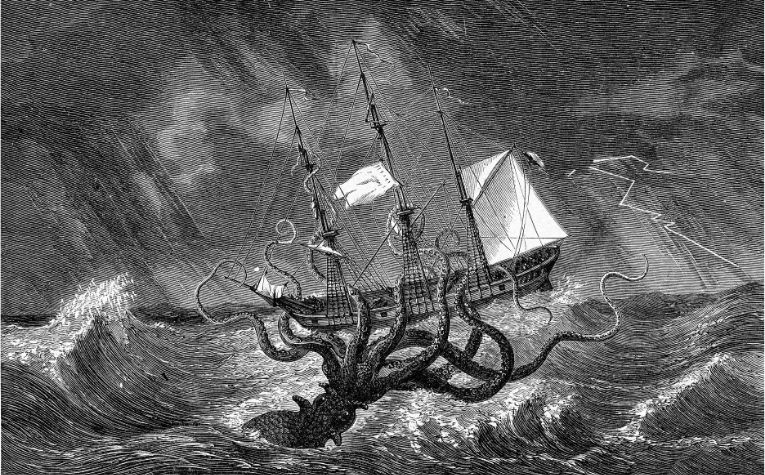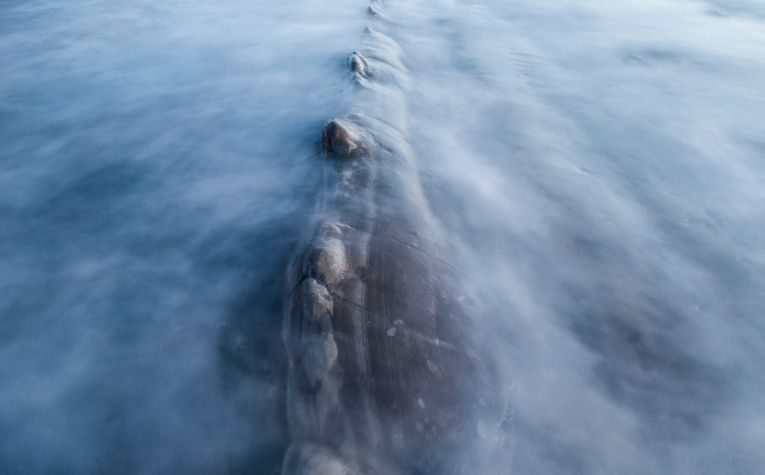For centuries, seafaring Scandinavians told tales of a fearsome beast that lived in the depths of the seas of Northern Europe.
Its body was immense, and its serpentine arms were so long that they could stretch out of the water and reach the tips of even the tallest ship’s masts.
The Kraken, as the creature came to be known, had the power and the disposition to sink ships and drag sailors to their watery graves.
The Kraken is a fantastical ocean-dwelling beast with origins that trace back to centuries-old Nordic legends and folklore.
Early accounts of this creature contain details that seem inconceivable, but scholars believe that the mythical Kraken was based on sightings of the very real giant squid.
Whether the ancient tales were based on earnest accounts, embellished stories, or mass hallucinations (or combinations thereof) cannot be conclusively stated.
What is certain is that just like the mythical Kraken, there are more questions than answers surrounding the giant squid.
Despite modern technology, it is an enigmatic creature that is just as elusive and mysterious as the legend it spawned.
Also, see Is the Kraken a Squid or an Octopus? to learn more.

Is the Kraken a Myth or Reality?
The Kraken rose to fame through Nordic folklore, which was shared through oral traditions.
In other words, the Kraken starred in cautionary tales that encouraged sailors to be vigilant on the high seas and in bedtime stories that kept children awake at night.
Centuries ago, just about any unexplained or tragic circumstances occurring on the high seas were squarely blamed on the mysterious Kraken.
Also, see 14 Great Books on Norse Mythology that explain the gods, heroes, and villains of these ancient stories of Scandinavia.
The Kraken’s True Identity Revealed
The Kraken legends were so widespread and ingrained in the Nordic culture that the legends swept up even prominent people in positions of power in politics and academia [1]:
- The King of Norway wrote of the Kraken in 1180
- The 13th-century scientific journal Konungs Skuggsja had an entry describing the Kraken’s gruesome appearance
- Renowned Swedish naturalist Carl Linnaeus classified the Kraken as a cephalopod in his 18th-century work Systema Naturae
Over time, tantalizing clues that would pull back the curtain on the Kraken myth and reveal its true nature began to emerge.
Clues were revealed by evidence washing ashore, drifting on the waves, or emerging in some of these other ways [2]:
- The first recorded discovery of a Kraken-like creature’s carcass occurred on a beach in Iceland in 1639
- Also, in the 17th century, whale hunters reported seeing strange chunks of tentacles in the vomit of mortally wounded sperm whales
- In the 1850s, carcasses of large cephalopods washed ashore on beaches along Denmark’s shoreline, and ultimately, it was the recovery of their large beaks that proved to be the vital link between the Kraken and the giant squid
- In 1857 Norwegian naturalist Japetus Steenstrup formally classified the large tentacled creature as Architeuthis dux, the giant squid, thus giving the mythical Kraken an official name and identification in the recognized animal kingdom
Also, see What Dragons Meant to Vikings to learn more.

The Kraken’s Incredible Features
The earliest accounts of the Kraken came from those who spent a great deal of time on Scandinavia’s seas, namely sailors and fishermen.
It was the vivid and fantastical descriptions provided by these “eyewitnesses” that fueled the Kraken myth and allowed its legend (and purported physical attributes) to grow to epic proportions.
Some of the Kraken’s incredible attributes included [3] [4]:
- A body so large that it could be mistaken for an island by unsuspecting sailors
- With its massive size, the Kraken was capable of generating giant whirlpools and rings of waves that could extend “many miles”
- Enormous tentacles that could encircle a ship and drag it and its crew below the surface
- Speaking of the Kraken’s tentacles, they were by some accounts more than a mile long
- The Kraken was a maneater, and when it was not feasting on human flesh, it would feed on an entire school of fish in one gulp
To gain a meaningful perspective of the Kraken’s reputed characteristics, one needs to look no further than the gentle blue whale.
The blue whale is not only the largest animal living in the world’s oceans today; it is by far and away the largest animal to have ever lived on the planet Earth, whether on land or in the sea.
The blue whale’s incredible proportions are well-documented and verified by modern science.
Here are some of the blue whale’s measurements [5]:
- Blue whales can grow to 100 feet in length
- They can weigh up to two hundred tons (400,000 pounds)
- A blue whale’s tongue is as heavy as an elephant, and its heart can weigh as much as an automobile
Since, to date, no fossils or remains of Kraken or giant squid coming even remotely close to the blue whale’s incredible proportions have been found, it is safe to say that accounts describing the Kraken’s inconceivable attributes were somewhat embellished (which is putting it mildly).
Although it is difficult to fault the justifiable enthusiasm with which a 12th-century sailor or fisherman would re-tell their face-to-face encounter with a giant squid, with the aid of scientific analysis and hard evidence, any debate as to the mythical Kraken’s existence was settled by the mid-19th century.
Nonetheless, the awe-inspiring traits of the Kraken still make for good storytelling and movie-making.
Also, see Has Anyone Seen the Kraken? to learn more.

The Giant Squid is Impressive by any Measure
Although no creature, past or present, can measure up to the gargantuan proportions credited to the mythical Kraken, the giant squid is an impressive animal in its own right and by any standard.
In fact, it is beyond dispute that it was largely owing to its imposing features that the giant squid was perceived by those who first encountered it in North Atlantic waters to be an ocean-dwelling monster.
Here is the tale of the tape of Architeuthis dux [6]:
- The longest giant squid measured by scientists comes in at 43 feet (13 meters), but it is theorized that they can reach a length of 66 feet (20 meters)
- Giant squid have eight arms with 2-inch suckers and two feeding tentacles, which can dart out over 30 feet (10 meters) and grab prey with hundreds of suction cups lined with sharp teeth
- Giant squid have eyes that measure 12 inches in diameter (30 centimeters) and are the size of dinner plates – as it turns out, the early accounts of the Kraken actually got this part right
- Where the arms converge at the giant squid’s body, its powerful, razor-sharp beak sits in which lies a tongue-like organ encrusted with numerous pointy teeth
The Kraken’s Elusiveness
Much of the mystery surrounding the Kraken can be attributed to the simple fact that apart from purported eyewitness accounts, there was no hard evidence for scholars and naturalists to examine aside from floating and beached carcasses.
Furthermore, live specimens were exceedingly difficult to observe as they seemingly came out of nowhere from the ocean’s depths.
Scientists now know that the giant squid dwells at roughly 2,000 feet below the ocean’s surface.
Incredibly, for as long as scientists have known about the giant squid, it was not until 2005 that researchers finally recorded a sighting of a live specimen that was raised to the surface.
Despite the combined efforts of a large community of scientists armed with modern technology, it was not until seven years later, during the summer of 2012, that Architeuthis dux was finally filmed in its natural habitat, deep in the darkest depths of the ocean.
And were it not for sheer determination, an innovative, ground-breaking approach, and a bit of luck, the hunt for video footage of the elusive giant squid in its natural domain could have continued to this day.
Conclusion
Old tales of the Kraken are more fantasy than reality, but given its popularity even today, the Kraken’s status exceeds myth; it is now legendary.
References:
[1] Source
[2] Source
[3] Source
[4] Source
[5] Source
[6] Source
[7] Source
